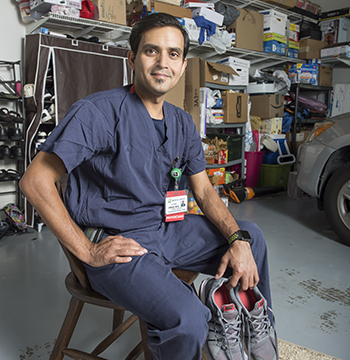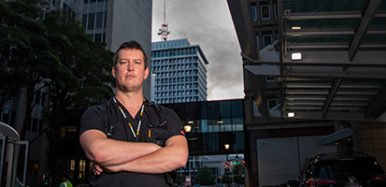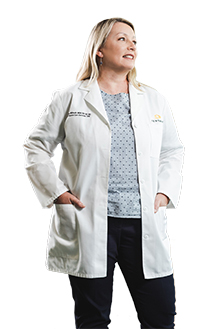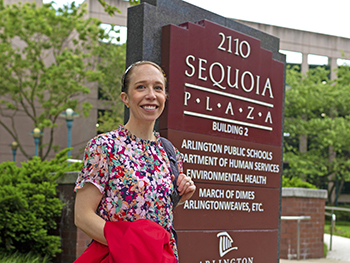The front line
Health care workers confront fear, sorrow and coronavirus
Kate Andrews //June 30, 2020//
The front line
Health care workers confront fear, sorrow and coronavirus
Kate Andrews //June 30, 2020//
Before the pandemic, disaster meant something different to most people — even hospital workers.
“It’s preparing for worst-case scenarios,” says Dr. Sandy Simons, an emergency room physician at Bon Secours Richmond Community Hospital. “When you talk about disaster medicine, you train for a bomb going off.”
A single traumatic event, in other words. Not a deadly virus that could send too many patients to the emergency room at once.
In March, Simons was worried about having enough masks, gloves, surgical gowns and other personal protective equipment (PPE) to keep herself and her colleagues safe. She worried about people in the neighborhoods around her hospital, which include some of the poorest residents of the city.
“We have a very special population,” Simons says. “It tends to be high rates of unemployment, no insurance, not as much access to health care, more co-morbidities.”
Simons’ mother was “beside herself with worry” and Simons herself was concerned about her household of four, afraid to even pet her dog before hitting the shower after work.
“I was thinking back in March that it was going to look like New York.”
By May, it was clear that Virginia was not going to be like New York in terms of COVID-19 hospitalizations and deaths.
As of mid-June, Virginia had 54,312 confirmed COVID-19 cases, 3,589 of which occurred among health care workers — 6.6% of the total. Across the state, about 8,400 people had been hospitalized due to the virus since the pandemic began, and more than 1,600 died.
Although Virginia hospitals saw plenty of coronavirus cases, especially in the hotspots of Northern Virginia and metro Richmond, regular health care business was way down because of a statewide ban on elective procedures in March and April. Out of fear for the virus, people also avoided hospitals in instances when they ordinarily would have sought care.
Due to these factors, Ballad Health, which serves Southwest Virginia and neighbors Tennessee, Kentucky and North Carolina, furloughed 1,300 employees and projected revenue losses of $150 million by mid-July. Bon Secours Mercy Health furloughed 700 employees across seven states in March, and Carilion Clinic saw regular inpatient care fall 40% to 70% by mid-April, leading to layoffs. Inova Health System in Northern Virginia laid off 427 workers in April, with the system saying it had lost hundreds of millions in revenue because of the pandemic.
Frontline medical professionals fighting the coronavirus worked 12- to 14-hour shifts in isolation wards, and self-quarantined from family members when they were home.
There were many unexpected moments of kindness, however: applause from people in cars parked outside hospitals, free lunches and homemade signs lauding their heroics. Although occasionally shy about expressing it, frontline health care providers are subject to feeling emotional about their work. Many felt a sense of excitement and fulfillment when helping the sickest patients. At other times, they felt the weight of the world on their shoulders.

Strength and solitude
Dr. Vikas Pathak, a pulmonologist who is chairman of Newport News-based Riverside Health’s clinical protocol committee, worked from about 6:30 a.m. to 8 or 9 p.m., seven days on and seven days off from March through May, but his schedule had settled down to its normal 12-hour shifts by June.
“The day starts with a quick meeting about how many positives, negatives and PPE supplies we have,” he explains. The rest of the day is spent checking in new patients, checking on existing patients and implementing protocols issued by the Centers for Disease Control and Prevention.
Going home from work, Pathak worried about spreading the virus to his wife, who is immunocompromised, or their 11-year-old son and 6-year-old daughter, who didn’t understand why he couldn’t give her hugs.
“When I’m working in the ICU, I quarantine myself from them,” he explains. He takes off his clothes in the garage, goes straight to the shower and sleeps in a different room.
The first night, he recalls, his daughter cried, “unconsolably. I couldn’t touch her.” By April, she understood why she couldn’t hug her dad.
The emotional toll of fighting the virus took some medical workers by surprise.
In April, Dr. Lorna Breen, medical director of the emergency department at NewYork-Presbyterian Allen Hospital in Manhattan, died of suicide at age 49 while visiting family in Charlottesville. She had spent weeks treating COVID-19 patients, many of whom died.
Her father, a doctor in Pennsylvania, told The New York Times, “Make sure she’s praised as a hero, because she was. She’s a casualty just as much as anyone else who has died.”

At VCU Medical Center, Myles Shifflett found himself in one of the riskiest jobs in the age of COVID-19: respiratory therapist. When he’s on the rapid response night shift, he initiates high-flow oxygen ventilators to help patients breathe and transports them to the ICU as necessary. The mechanics of starting a ventilator leaves the therapist in close range to the patient’s face and at heightened risk of contracting the virus.
“Maintaining the airway and keeping the patient breathing with optimal oxygen saturation is my greatest priority,” he says. A second, unwritten priority for Shifflett and many emergency health care workers is staying calm and cool in the face of danger.
“We are strong,” Shifflett says, noting how impressed he’s been by his colleagues’ positivity and resilience. “We’ve seen the type of things that most people will never see on a regular basis. So, with that type of experience, I’d say we’re able to stay more calm and collected in the face of death and violence than the average person. Also, taking precautions against serious contagions is nothing new to us. We are being super diligent and hyper-aware of this particular virus. … It is definitely the most concerned I’ve ever been, but that’s not to say that I’m afraid.”
Emotional roller coaster
For other medical workers, fighting the coronavirus has taken some adjustment.
After her first day of donning and removing protective wear 17 times over a 12-hour shift, “I was really shaky when I came home,” recalls Cheryl Rilee, a registered nurse at Bon Secours St. Francis Medical Center in Chesterfield County.
Rilee usually assists with cardiac surgeries, but when nonemergency surgeries were canceled during March and April under an executive order from Gov. Ralph Northam, her hospital asked her to work a few shifts caring for the sickest COVID-19 patients since she had 15 years of prior ICU experience.
“They were paralyzed, sedated and ventilated,” she recalls, but “I always talk to my patients like they know what’s going on. I feel like that’s part of the personal care. Lots of stroking their hair. … I did feel really sad for them because they couldn’t see their families. I feel so bad that they’re alone.”
Working with very sick people, especially when they’re alone and frightened, is emotionally difficult for health care workers who aren’t accustomed to standing in for concerned relatives at a patient’s bedside.

“When you’re working with a patient and they do pass, it takes all of us,” says Donna Wilmoth, a nurse executive at Sentara Williamsburg Regional Medical Center. “These are very ill individuals, and the nurses work with them closely.”
From March through May, two family members of each dying patient were allowed to put on isolation garb “so they can see their loved one,” says Genemarie McGee, Wilmoth’s colleague and Sentara Healthcare’s chief nursing officer.
Rilee recounts caring for one extremely ill patient on a ventilator for two days. “I would talk to her sister by phone and give her updates. I told her I wanted her to call any time she needed to,” Rilee says.
As the patient began to improve, her sister, brother-in-law and nephew FaceTimed her. Then the patient was able to move out of the ICU and, finally, the hospital.
A multifront war
Experiences differ by region and by hospital. Maria Monninger, a registered nurse at Carilion Roanoke Memorial Hospital, graduated three years ago from Radford University. Some of her friends work in Northern Virginia, where the caseload has been much heavier.
Nevertheless, her parents have been worried for her.
“I’m a pretty healthy, young adult, so I felt pretty confident going into a room [with COVID patients],” she says.
At University of Virginia Medical Center, officials opened a new floor for a critical care unit in March. “We’re prepared to take more patients,” says veteran nurse Barb Trotter, who oversees nurse scheduling for the hospital’s COVID-19 command center. However, “the big challenge would be if we got a call, if 50 patients had to come in all of a sudden. We might have the bed capacity, but we may not have the staff. I’ve never seen anything like this before. It affects the whole health system.”
Dr. Marsh Cuttino, an emergency physician and chairman of emergency medicine at HCA’s Henrico Doctors’ Hospitals, saw one COVID-19 patient who was 26 days old and another in their 90s.
Cuttino’s wife is a nurse who works at the Daily Planet Health & Services, a free clinic in Richmond that assists homeless people. “We joke, ‘Who’s going to get [COVID-19] first?’” Cuttino says. “We are trying not to bring it into the house.”
The term “frontline medical workers” doesn’t just include emergency room and ICU providers. Michael Roth is a Henrico County fire captain, paramedic and registered nurse who gets called to nursing homes and private residences.
Although the number of ER visits and 911 calls fell during the spring, Roth saw an uptick in COVID-19 calls at his station, especially from long-term, skilled care facilities.
“There is definitely a heightened level of awareness entering a nursing home,” he says. “It’s a denser population. … We’re probably using five gowns on a shift, gloves on each call, [but] the eye protection is reusable,” Roth says.
“Frontline” also can mean providing care via phone. Amy Sapronetti, a trained pediatric nurse in Arlington County, is a Medical Corps of Virginia volunteer. She’s a team leader for a group of contact tracers who talk to COVID-19 patients, providing a mix of counseling and comforting while investigating who the patients came into contact with before they became ill.

“It can be really intense,” she says. “We are there to provide calming reassurance to these folks. We care about your loved ones.”
Sapronetti, like many health care workers, found herself with not as much work to do after the pandemic hit Virginia in mid-March. Her background in emergency nursing proved valuable for the Medical Corps, which has seen thousands of volunteers join this spring. In Arlington alone, the corps went from 325 volunteers to 802 in a matter of weeks.
“I am in it for the long run,” Sapronetti says. “I knew when I responded, it would empower me. I’ve seen a lot. I started out my career in emergency nursing. This is just intense in a different way. I feel like this work has increased meaning.”
Pathak also understands the pull of volunteering. He did his residency in the Bronx and initially signed up to volunteer in New York City, where the virus has killed more than 24,000 people. However, he was needed in Hampton Roads and wasn’t able to go.
“Things have been very stretched,” Pathak says. “I’m dying to go there, but I don’t know how much my wife would appreciate that. So many things to think about.”
Subscribe to Virginia Business.
e


















